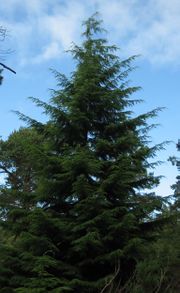Tsuga heterophylla
| Tsuga heterophylla | |
|---|---|
 |
|
| Western Hemlock foliage and cones | |
| Conservation status | |
| Scientific classification | |
| Kingdom: | Plantae |
| Division: | Pinophyta |
| Class: | Pinopsida |
| Order: | Pinales |
| Family: | Pinaceae |
| Genus: | Tsuga |
| Species: | T. heterophylla |
| Binomial name | |
| Tsuga heterophylla (Raf.) Sarg. |
|
 |
|
| Range | |
Tsuga heterophylla (Western Hemlock) is a species of hemlock native to the west coast of North America, with its northwestern limit on the Kenai Peninsula, Alaska, and its southeastern limit in northern Sonoma County, California.[2][3]

It is a large evergreen coniferous tree growing to 50-70 m tall, exceptionally 78 m, and with a trunk diameter of up to 2.7 m. It is the largest species of hemlock, with the next largest (Mountain Hemlock T. mertensiana) reaching a maximum of 59 m. The bark is brown, thin and furrowed. The crown is a very neat broad conic shape in young trees with a strongly drooping lead shoot, becoming cylindric in older trees; old trees may have no branches in the lowest 30-40 m. At all ages, it is readily distinguished by the pendulous branchlet tips. The shoots are very pale buff-brown, almost white, with pale pubescence about 1 mm long. The leaves are needle-like, 5-23 mm long and 1.5–2 mm broad, strongly flattened in cross-section, with a finely serrated margin and a bluntly acute apex. They are mid to dark green above; the underside has two distinctive white bands of stomata with only a narrow green midrib between the bands. They are arranged spirally on the shoots but are twisted at the base to lie in two ranks on either side of the shoot. The cones are small, pendulous, slender cylindrical, 14-30 mm long and 7-8 mm broad when closed, opening to 18-25 mm broad. They have 15–25 thin, flexible scales 7-13 mm long. The immature cones are green, maturing gray-brown 5–7 months after pollination. The seeds are brown, 2-3 mm long, with a slender, 7-9 mm long pale brown wing.[2][3]
Ecology
It is closely associated with temperate rain forests, and most of its range is less than 100 km from the Pacific Ocean. There is however an inland population in the Rocky Mountains in southeast British Columbia, northern Idaho and western Montana. It mostly grows at low altitudes, from sea level to 600 m, but up to 1800 m in the interior part of its range in Idaho.[2][3]
Initial growth is slow; one year old seedlings are commonly only 3-5 cm tall, and two year old seedlings 10-20 cm tall. Once established, saplings in full light may have an average growth rate of 50-120 cm (rarely 140 cm) annually until they are 20-30 m tall, and in good conditions still 30-40 cm annually when 40-50 m tall.
It is a very shade-tolerant tree, with young plants typically growing up under the canopy of other conifers such as Sitka Spruce and Douglas-fir, then eventually replacing them in climax forest as those species cannot grow in the dense shade cast by Western Hemlocks. However, storms and (rarely) wildfires will create larger openings in the forest where these other species can then regenerate. The tallest specimen, 78.9 m tall, is in Prairie Creek Redwoods State Park, California (USA). It is long-lived, with trees over 1200 years old known.[3]
Cultivation and uses
Western Hemlock is the state tree of Washington.[4]
Western Hemlock is cultivated in its native territories, where its best reliability is seen in wetter regions. In relatively dry areas, as at Victoria, British Columbia, it is exacting about soil conditions. It needs a high level of organic matter (well-rotted wood from an old log or stump is best; animal manures may have too much nitrogen and salt) in a moist, acidic soil.
Western Hemlock boughs are used to collect herring eggs during the spring spawn in southeast Alaska. The boughs provide an easily collectible surface for the eggs to attach to as well as providing a distinctive taste. This practice originates from traditional gathering methods used by Native Alaskans from southeast Alaska, specifically the Tlingit people.
The edible cambium can be collected by scraping slabs of removed bark. The resulting shavings can be eaten immediately, or can be dried and pressed into cakes for preservation. The bark also serves as a source of tannin for tanning.
Tender new growth needles (leaves) can be chewed directly or made into a bitter tea, rich in vitamin C (similar to some other hemlock and pine species).
Outside of its native range, Western Hemlock is of importance in forestry for timber and paper production, and as an ornamental tree in large gardens, in northwest Europe and southern New Zealand. It is naturalised in some parts of Britain and New Zealand, though not so extensively as to be considered an invasive weed tree.
References
- ↑ Conifer Specialist Group (1998). Tsuga heterophylla. 2006. IUCN Red List of Threatened Species. IUCN 2006. www.iucnredlist.org. Retrieved on 12 May 2006.
- ↑ 2.0 2.1 2.2 Farjon, A. (1990). Pinaceae. Drawings and Descriptions of the Genera. Koeltz Scientific Books ISBN 3-87429-298-3.
- ↑ 3.0 3.1 3.2 3.3 Gymnosperm Database: Tsuga heterophylla
- ↑ Washington State Government: State Symbols
|
|||||